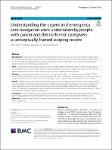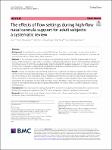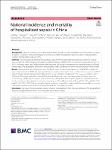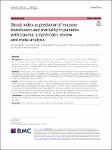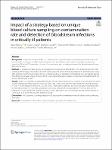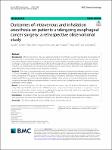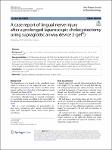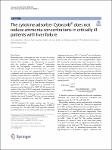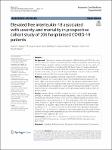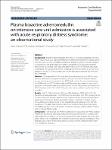Search
Search Results
People with cancer frequently use urgent and emergency care. Reviews of research have focussed on the incidence and predictors of service use in this population, rather than how people make decisions about which service to access. Understanding what factors influence these choices will inform ways in which we might enable people with cancer to effectively access services. |
During high-flow nasal cannula (HFNC) therapy, flow plays a crucial role in the physiological effects. However, there is no consensus on the initial flow settings and subsequent titration. Thus, we aimed to systematically synthesize the effects of flows during HFNC treatment. |
Sepsis is a leading cause of preventable death around the world. Population-based estimation of sepsis incidence is lacking in China. In this study, we aimed to estimate the population-based incidence and geographic variation of hospitalized sepsis in China. |
Management of bleeding trauma patients is still a difficult challenge. Massive transfusion (MT) requires resources to ensure the safety and timely delivery of blood products. Early prediction of MT need may be useful to shorten the time process of blood product preparation. The primary aim of this study was to assess the accuracy of shock index to predict the need for MT in adult patients with trauma. For the same population, we also assessed the accuracy of SI to predict mortality. |
Unique blood culture (UBC) has been proposed to limit the number of venipuncture and to decrease the risk of BC contaminations (BCC) without affecting their yield. We hypothesized that a multi-faceted program based on UBC in the ICU may reduce the rate of contaminants with a similar performance for bloodstream infections (BSI) identification. |
Different anesthetics may have opposite effects on the immune system, thus affecting the prognosis of tumor patients. Cell-mediated immunity forms the primary defense against the invasion of tumor cells, so manipulation of the immune system to produce an enhanced anti-tumor response could be utilized as an adjuvant oncological therapy. Sevoflurane has proinflammatory effects, while propofol, has anti-inflammatory and antioxidant effects. Therefore, we compared the overall survival (OS) and disease-free survival (DFS) of patients with esophageal cancer under total intravenous anesthesia and inhalation anesthesia. |
The lingual nerve is a branch of the mandibular nerve which is a branch of the trigeminal nerve and provides general sensation to the anterior two-thirds of the tongue, and this nerve lies deep to the hyoglossus muscle (Dotiwala and Samra 2018). |
Hemadsorption techniques are used in critical care for numerous indications, although the evidence is often limited. One example is the elimination of ammonia with the cytokine adsorber Cytosorb® (adsorption based on hydrophobic interactions of substances with a molecular weight of 5–55 kDa). Most recently, in vitro and in vivo data postulated that Cytosorb® (combined with continuous kidney replacement therapy (CKRT)) could eliminate ammonia [1, 2]. |
Divergence between deterioration to life-threatening COVID-19 or clinical improvement occurs for most within the first 14 days of symptoms. Life-threatening COVID-19 shares clinical similarities with Macrophage Activation Syndrome, which can be driven by elevated Free Interleukin-18 (IL-18) due to failure of negative-feedback release of IL-18 binding protein (IL-18bp). We, therefore, designed a prospective, longitudinal cohort study to examine IL-18 negative-feedback control in relation to COVID-19 severity and mortality from symptom day 15 onwards. |
Bioactive adrenomedullin (bio-ADM) is a vasoactive peptide with a key role in reducing vascular hyperpermeability and improving endothelial stability during infection, but it also has vasodilatory properties. Bioactive ADM has not been studied in conjunction with acute respiratory distress syndrome (ARDS), but it has recently been shown to correlate with outcomes after severe COVID-19. Therefore, this study investigated the association between circulating bio-ADM on intensive care unit (ICU) admission and ARDS. The secondary aim was the association between bio-ADM and ARDS mortality. |

